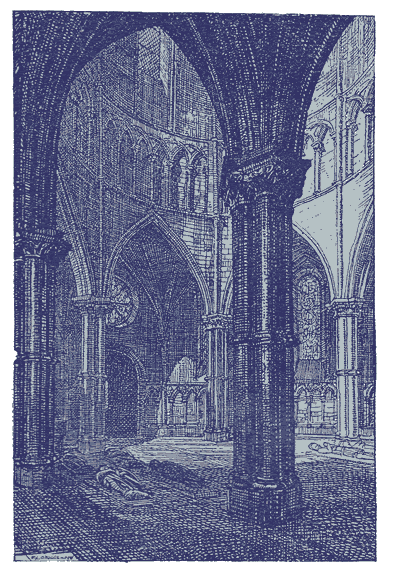|
The Inner Temple
The Temple Church |
|
The Coat of Arms of the Inner Temple is constituted - Azure, a Pegasus saltant argent, i.e., on a blue field a silver winged horse saltant. The explanation runs- He beareth azure a Pegasus (Flying Horse) argent called the horse of honour, whose condition Sorares the XXIII Emperor of Assiria honoured so much for his swift course, as he judged him not framed of the grosse masse of common horses. And therefore S. Gefferie Chaucer built unto him (after his owne nature and condition a house called Fame, a place meete for the horse of honour) the poetes faine was when valiant Perseus, the souldior of the goddes Pallas, in dangerous fight atchiued by helpe of her glittering shielde the battaile against Medusa, the King of Phorcius, who, wen he had severed the head of this ouglie monster, straight gusht out the streames of bloud in such abundance as thereof grew the flying horse, to show forth the fame of so happy a conquest ; who, taking flight towards the heavens ( where hee is now fixed), strake with his eete the highest toppe of Mount Helicon, from whence immediately rose the fountaine ( Hypocrene), wherein the muses take their delight and bathe, which fountaine sithence in all ages hath sufficiently watered the growing plantes of the pleasant countries adjoining. And lately so with cleare streamer bath abounded as exceeding the old limits burst foorth the bankes, reaching them seles to countries farther distant, moystening the soyles thereof. 0n account of its antiquity the Inner Temple demands first History. attention as an Inn of Court. The headquarters of this Honourable Society undoubtedly succeeded to the ancient hall or refectory of the Knights Templars, but the date of this ancient building is only a matter of conjecture. Some writers place the date of its erection as early as the 8th Century. It is very probable, however, that it was standing when the Round of the Church was building by the Templars in 1185. The establishment of the Templars in London doubtless took place in the reign of Henry II. It is on record that towards the end of the reign of that King the Knights Templars, who were then in plenitude of their power throughout Europe, removed from the Old Temple in Holborn, which stood on the site of the present Southampton Buildings, and took up their residence on the banks of the Thames on the space extending from White-friars to Essex House without Temple Bar. From henceforth this residence obtained the name of Novum Templum. Prior to the occupation of the Temple by the Templars, the river was the great highway between the Cities of London and Westminster. At that time Fleet Street did not exist. It is interesting to recall that of the three military orders founded in the 12th Century, that of the Knights Templars, or Red Cross Knights, the founders of the Inner Temple, was, perhaps, the most renowned. It is usually stated that there were two founders, Hughes de Payons, or de Pagenès, and Geoffroi de St. Omar, or St. Adhemar. The former greatly distinguished himself in the capture of Jerusalem in 1099. With eight companions he returned from Europe to the Holy Land under a self-imposed task of guarding the public roads leading to the Holy City for the protection of pilgrims and others who were now thronging the mountain passes leading to the Holy Shrine. IT is interesting to note that Sir Christopher Hatton, Lord Chancellor of England, the accomplished rival of Leicester in the affections of Queen Elizabeth, was a student in the Inner Temple. The date of the foundation of the Library of the Inner Temple is not exactly known ; but the existence of the Library can undoubtedly be traced back to the year 1540. In the middle of the 17thC the library received a considerable benefaction from the well-known Wm. Petyt, Keeper of the Tower. Besides money, he gave a liberal collection of manuscripts. Site Copyright ickledirectory.co.uk. The text was first written in 1910 by an anonymous diarist. |
